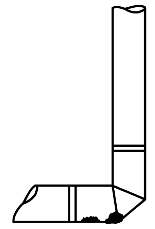Don't keep it all bottled in - Vent it!
A guide to gas appliances and how to safely and properly vent
Gas appliances are divided into four venting categories based on vent operating pressure (as positive or negative) and whether they are condensing (i.e.: flue products with a
temperature of less than 275°F or 135°C, that have a high probability of condensation forming in the vent) or non-condensing. These categories are used to determine the type of vent that
should be used for the appliance.
Category I - Negative pressure, non-condensing
A chimney is a good example of this. Negative pressure sucks the products of combustion from the appliance breech and deposits them outdoors.
Category I appliances require Type B gas vents. Type B gas vents are used with natural gas or liquid propane Category I and draft hood equipped appliances. Never use a Type B gas vent on any
appliance that is not listed and approved for venting with a Type B gas vent..
|

No special considerations
|
Category II - Negative pressure; condensing
Negative pressure vents are used with combustion gases at or below the dew point. The vent material must be non-corrosive because of the high probability of condensation.
|

Corrosion resistant
|
Category III - Positive pressure, non-condensing
These products will access a direct sidewall or roof, vented without additional apparatus. Positive pressure requires that any joints in the flue be absolutely water and air tight.
Due to the high flue-gas temperatures, condensation is not expected to occur in the vent systems for these products. However the flue gases generated by these appliances
are close to the dew point, therefore corrosion resistant materials are recommended. Drains are typically installed to remove flue condensation from the vent pipe, as a provision.
Neptronic SKG gas humidifiers are considered as Category III appliances and require a Type BH gas vent, rated for flue temperatures up to 390°F (217°C). |


Corrosion resistant
|
Category IV - Positive pressure, condensing
These appliances are designed to dispose of excessive flue condensate as well as condensate formed within the secondary heat exchanger. |

CWater and air tight & corrosion resistant
|
General installation requirements for the SKG humidifiers
The SKG steam humidifier must be installed with:
- A listed BH vent Class I with a single or double wall system for a Category III appliance;
- The vent must be fabricated from AL29-4C stainless steel and be air and water tight;
- The horizontal vent pipe must be sloped upward toward the termination at a minimum of ¼ inch per foot and be installed so that all condensate runs back toward the drain and is not retained in any part of the venting system;
- A drain fitting must be located as close as possible to the SKG flue outlet. Depending on the arrangement of the vent, more than one drain may be required in the venting system;
- Additional appliances may not be interconnected to any part of the venting system of the SKG unit; and
- A Category III appliance may not be interconnected to any part of a vent system common with a natural draft or draft hood appliance.
Type BH gas vents are classified into Class I or Class II temperatures (*Note that the SKG requires a Class I venting system):
Class I temperatures are defined as more than 275°F (135°C) but less than 473°F (245°C).
Class II temperatures are defined as 275°F (135°C) or less and classified into four different ratings:
- A) Temperatures up to and including 149°F (65°C);
- B) Temperatures up to and including 194°F (90°C);
- C) Temperatures up to and including 230°F (110°C) and;
- D) Temperatures up to and including 275°F (135°C).
Warning
While plastic pipe has the advantages of corrosion resistance and leak-tight assembly, the systems 636 PVC and 636 CPVC , although they are listed as BH Class II vent type, are NOT suitable for
the SKG units because of their temperature limitation.
Reference
http://www.ehow.com/list_7285461_types-gas-vents-there_.html
Fundamentals of Venting 34-4010-02